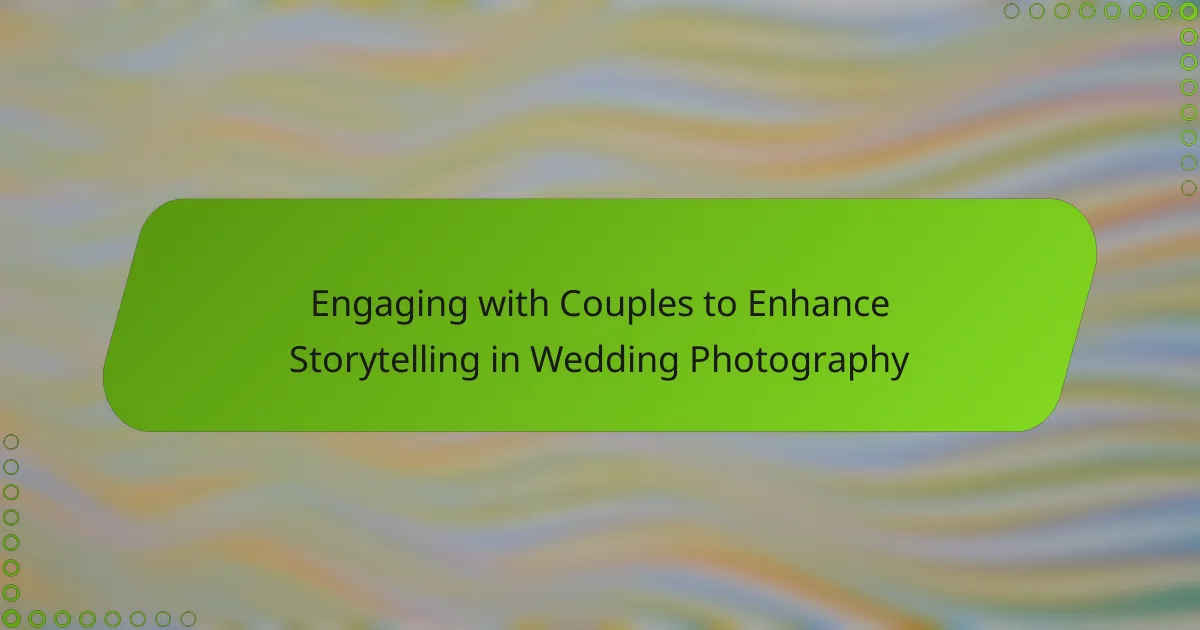Engaging with couples is essential for enhancing storytelling in wedding photography, as it allows for a deeper understanding of their unique love story. By incorporating personal elements and fostering collaboration through consultations and interactive sessions, photographers can create meaningful images that truly reflect the essence of the couple’s relationship.
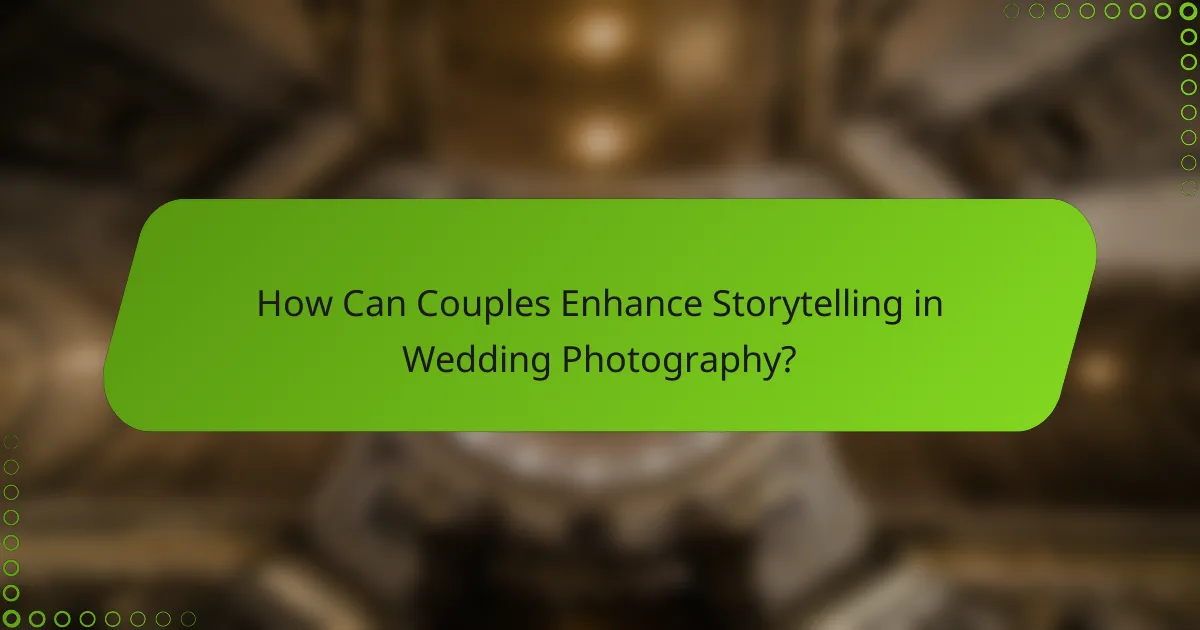
How Can Couples Enhance Storytelling in Wedding Photography?
Couples can enhance storytelling in wedding photography by actively participating in the creative process, focusing on personal elements that reflect their unique relationship. This collaboration leads to more meaningful images that capture the essence of their love story.
Personalized Themes
Choosing a personalized theme for the wedding can significantly enhance storytelling in photography. Couples should consider their interests, hobbies, or shared experiences as inspiration for the theme. For example, a vintage theme might incorporate retro decor and attire, creating a nostalgic atmosphere that can be beautifully captured in photos.
It’s essential to communicate the chosen theme to the photographer, ensuring they can plan shots that align with the overall aesthetic. This alignment helps create a cohesive visual narrative throughout the wedding album.
Emotional Connection
Building an emotional connection during the wedding day is crucial for authentic storytelling. Couples should prioritize moments that evoke genuine emotions, such as heartfelt vows or candid interactions with family and friends. These moments often yield the most impactful photographs.
To foster this connection, couples can engage in pre-wedding activities, like a first look or private moments before the ceremony. These intimate settings allow for authentic expressions of love and joy, which the photographer can capture beautifully.
Incorporating Personal Stories
Integrating personal stories into the wedding photography can make the images more relatable and meaningful. Couples can share anecdotes about their relationship, such as how they met or memorable trips taken together, which can inspire specific shots or poses.
For instance, if a couple has a favorite travel destination, they might incorporate elements from that place into their decor or attire, allowing the photographer to weave these stories into the visual narrative.
Interactive Elements
Including interactive elements during the wedding can enhance engagement and storytelling. Activities like photo booths, guest books, or interactive games encourage guests to participate, resulting in candid moments that the photographer can capture.
Couples should consider setting up stations where guests can leave messages or photos, creating a dynamic storytelling experience that reflects the joy of the celebration. These elements add depth to the wedding album, showcasing the couple’s unique personality and the fun atmosphere.
Unique Locations
Selecting unique locations for wedding photography can elevate the storytelling aspect. Couples should consider venues that hold special meaning, such as the place of their first date or a favorite park. These locations provide a backdrop that resonates with their love story.
Additionally, exploring diverse settings, like urban landscapes or natural vistas, can offer a variety of visual styles. Couples should discuss potential locations with their photographer to ensure they can capture the essence of each site effectively, enhancing the overall narrative of the wedding day.
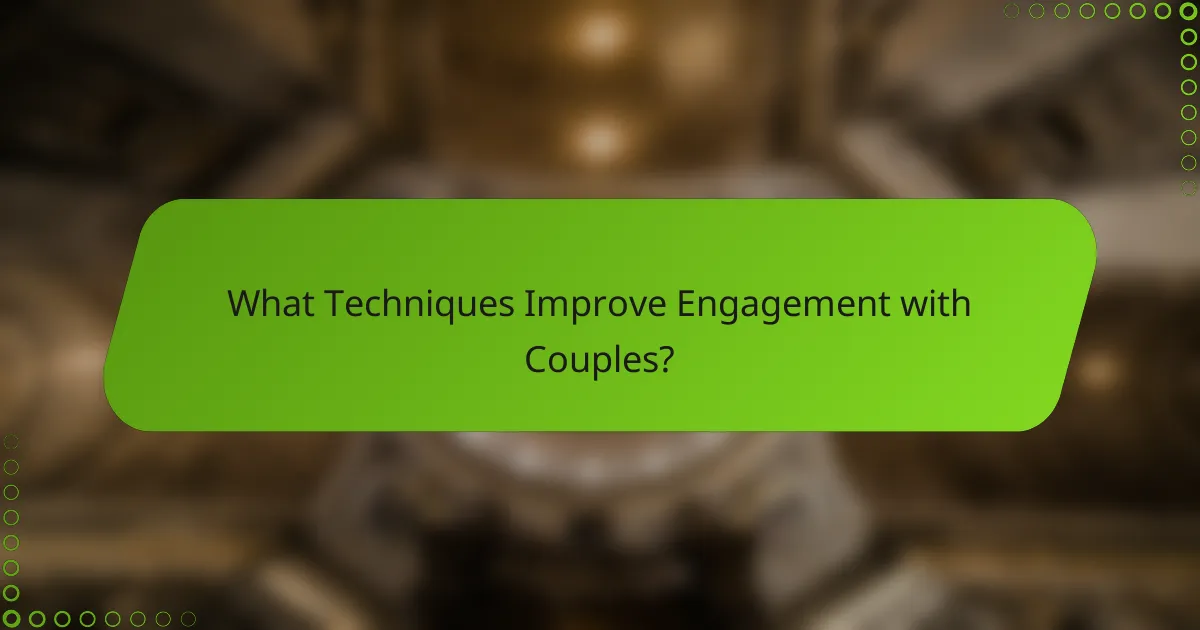
What Techniques Improve Engagement with Couples?
Engaging with couples effectively enhances storytelling in wedding photography by fostering a deeper connection and understanding of their unique narrative. Techniques such as pre-wedding consultations, interactive questionnaires, and storyboarding sessions can significantly improve this engagement.
Pre-Wedding Consultations
Pre-wedding consultations are essential for building rapport with couples. These meetings allow photographers to discuss the couple’s vision, preferences, and any specific moments they want captured, ensuring that the photography aligns with their expectations.
During these consultations, consider discussing the couple’s love story, their favorite locations, and any cultural or personal elements they wish to incorporate. This information can guide your approach and help create a more personalized experience.
Interactive Questionnaires
Interactive questionnaires serve as a valuable tool for gathering detailed insights from couples. These forms can include questions about their relationship, preferred styles, and must-have shots, which help photographers tailor their services to meet the couple’s desires.
To maximize effectiveness, keep the questionnaire concise yet comprehensive, aiming for around 15-20 questions. This balance encourages thoughtful responses without overwhelming the couple, leading to richer storytelling opportunities.
Storyboarding Sessions
Storyboarding sessions involve collaboratively mapping out the wedding day to visualize key moments and desired shots. This technique not only clarifies expectations but also allows couples to express their creative ideas, ensuring their story is told authentically.
During these sessions, use visual aids like mood boards or sample images to inspire discussion. Aim to finalize a storyboard that highlights significant events, such as the ceremony, reception, and candid moments, creating a roadmap for the photography process.
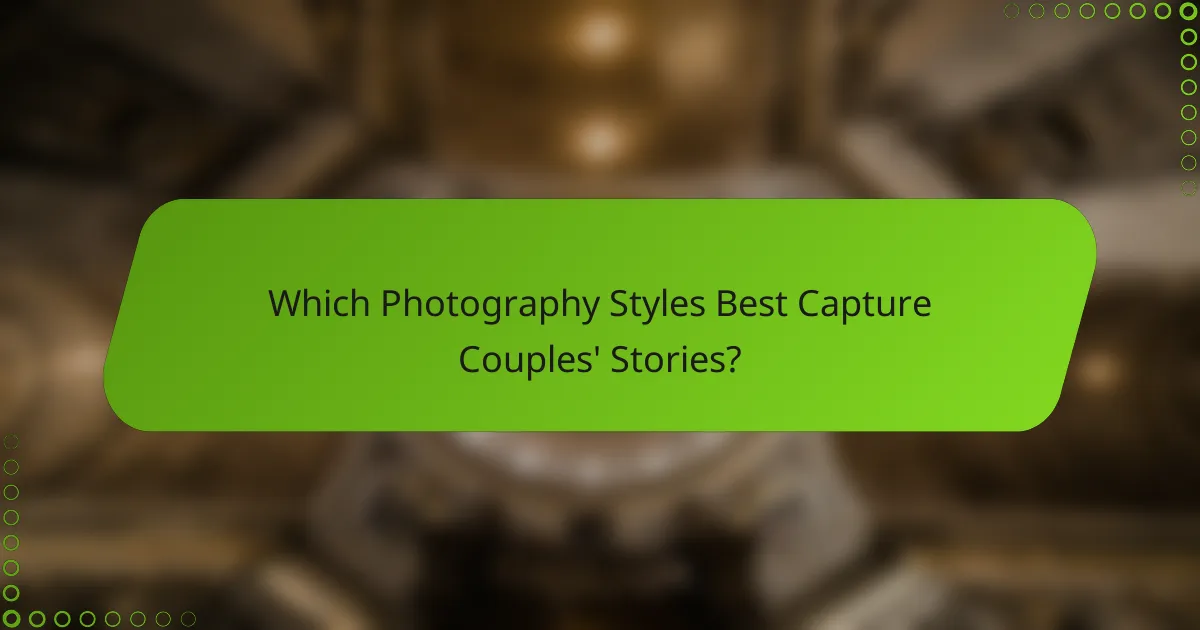
Which Photography Styles Best Capture Couples’ Stories?
To effectively capture couples’ stories, consider styles that emphasize genuine emotions and unique narratives. Candid, documentary, and fine art photography each offer distinct approaches that can enhance storytelling in wedding photography.
Candid Photography
Candid photography focuses on capturing spontaneous moments without posed interactions. This style allows for authentic emotions to shine through, making it ideal for documenting the natural dynamics between couples and their guests. Photographers should remain unobtrusive, blending into the background to seize genuine reactions and interactions.
To maximize the effectiveness of candid shots, communicate with the couple about key moments they want captured, such as laughter, tears, or shared glances. This approach often results in a rich tapestry of images that tell a compelling story of the day.
Documentary Style
Documentary style photography aims to narrate the wedding day as it unfolds, focusing on the events and emotions in a chronological manner. This style often includes a mix of candid and posed shots but emphasizes storytelling through the sequence of images. Photographers should be prepared to capture everything from the preparation to the reception, creating a visual timeline of the couple’s journey.
When using this style, it’s important to discuss the couple’s expectations and any specific moments they want highlighted. This ensures that the final collection resonates with their unique story and reflects the essence of their celebration.
Fine Art Photography
Fine art photography combines artistic vision with wedding documentation, focusing on aesthetics and composition. This style often involves creative angles, lighting, and post-processing techniques to produce visually striking images that feel more like art pieces than traditional wedding photos. Couples seeking a unique and artistic representation of their day may prefer this approach.
To achieve the best results, photographers should collaborate closely with the couple to understand their artistic preferences and vision. This might include selecting specific locations or themes that resonate with their personal story, ensuring that the final images are not only beautiful but also meaningful.

What Equipment Enhances Wedding Storytelling?
To enhance storytelling in wedding photography, the right equipment is essential. Key tools include DSLR cameras, wide-angle lenses, and drone photography, each contributing uniquely to capturing the essence of the day.
DSLR Cameras
DSLR cameras are favored for their versatility and image quality, making them ideal for wedding photography. They allow for interchangeable lenses and typically perform well in various lighting conditions, which is crucial for indoor and outdoor ceremonies.
When selecting a DSLR, consider models with fast autofocus and a high ISO range to handle low-light situations, such as evening receptions. Popular choices often include brands like Canon and Nikon, which offer a range of options from entry-level to professional-grade cameras.
Wide-Angle Lenses
Wide-angle lenses are essential for capturing expansive scenes, such as large wedding venues or group shots. These lenses typically have a focal length between 14mm and 35mm, allowing photographers to include more of the environment in their shots.
Using a wide-angle lens can create a sense of depth and context in images, making them more engaging. However, be cautious of distortion, especially at the edges of the frame. A good practice is to use these lenses for establishing shots while switching to standard or telephoto lenses for portraits.
Drone Photography
Drone photography adds a unique perspective to wedding storytelling, capturing breathtaking aerial shots of the venue and guests. Drones can provide stunning overhead views that traditional photography cannot achieve, making them a valuable addition to any wedding package.
When using drones, ensure compliance with local regulations regarding airspace and privacy. In many areas, you may need to register your drone and obtain permits for commercial use. Additionally, consider the weather and wind conditions, as they can significantly impact drone performance and safety.
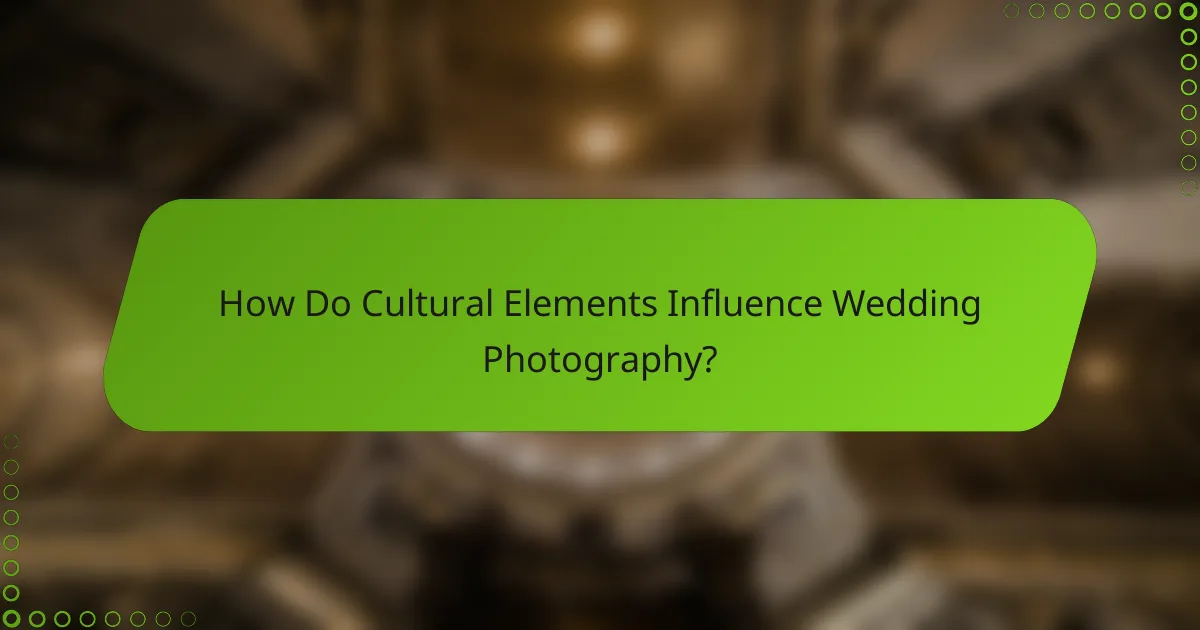
How Do Cultural Elements Influence Wedding Photography?
Cultural elements significantly shape wedding photography by dictating the themes, styles, and rituals captured during the event. Understanding these influences allows photographers to create more meaningful and personalized images that resonate with the couple’s heritage and values.
Incorporating Traditions
Incorporating traditions in wedding photography involves recognizing and documenting specific customs that are important to the couple’s culture. This might include rituals such as the exchange of vows, traditional dances, or unique ceremonies that reflect their backgrounds. Photographers should communicate with couples beforehand to identify these key moments and ensure they are highlighted in the final images.
For example, in a Hindu wedding, capturing the ‘saat phere’ or seven circles around the sacred fire is essential. Similarly, in a Jewish wedding, the breaking of the glass is a significant moment that should be prominently featured.
Symbolic Elements
Symbolic elements in wedding photography refer to objects or actions that carry deeper meanings within a culture. These can include items like wedding rings, specific flowers, or even colors that hold significance. Photographers should be aware of these symbols and strive to capture them in a way that conveys their importance.
For instance, red is often a symbol of luck and prosperity in many Asian cultures, making it a popular choice for wedding attire and decorations. Highlighting such colors in photographs can enhance the storytelling aspect of the images.
Regional Styles
Regional styles of wedding photography vary widely based on local customs and aesthetics. Photographers should adapt their techniques to reflect the unique characteristics of the region where the wedding takes place. This may involve using specific backdrops, lighting styles, or post-processing techniques that align with local traditions.
For example, in Mediterranean weddings, bright, natural light and vibrant colors are often emphasized, while in Scandinavian weddings, a more minimalist and subdued approach may be preferred. Understanding these regional nuances can help photographers create images that resonate with the couple and their families.
